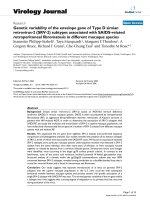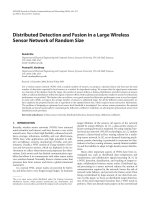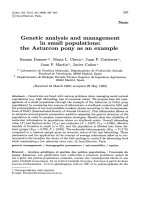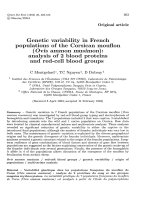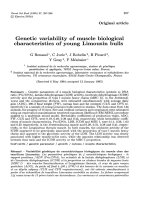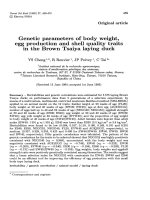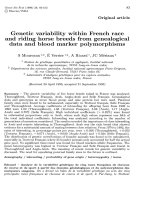Báo cáo sinh học: "Genetic variability and differentiation in red deer (Cervus elaphus L) of Central Europe" pps
Bạn đang xem bản rút gọn của tài liệu. Xem và tải ngay bản đầy đủ của tài liệu tại đây (869.38 KB, 18 trang )
Original
article
Genetic
variability
and
differentiation
in
red
deer
(Cervus
elaphus
L)
of
Central
Europe
GB
Hartl
R
Willing
G
Lang
F Klein
3
J
Köller
1
Forschungsinstitut
flr
Wildtierkunde
der
Veterinarmedixinischen
Universita,t
Wien,
Savoyenstrasse
1,
A-1160
Vienna,
Austria;
2
26
A,
Rue
Principale,
67240
Gries;
3
ONC,
Centre
National
d’Etude
et
de
Recherche
Appliqu6e
sur
les
Cervidés-Sangliers,
Section
Cerf,
8
rue
Adolphe
Seyboth,
67000
Strasbourg,
France;
4
University
of Agricultural
Sciences,
Institute
of Zoology
and
Game
Biology
Pater
Karoly
u,
1,
H-2103
Gi5do5lia,
Hungary
(Received
25
September
1989;
accepted
2
May
1990)
Summary -
A
total
of
365
specimens
of
red
deer
(Cervus
elaphus
L)
from
France,
Hungary
and
Austria
were
examined
for
genetic
variability
and
differentiation
at
34-
43
isoenzyme
loci
by
means
of
horizontal
starch
gel
electrophoresis
and
enzyme
specific
staining
procedures.
Calculated
over
34
loci,
mean
P is
11.4%
(SD,
2.05%)
and
mean H
is
3.5%
(SD,
0.8%).
These
values
are
similar
to
those
detected
in
other
studies
on
red
deer.
Relative
genetic
differentiation
(Gg
T)
is
10.4%,
but
absolute
genetic
distances
are
very
small
throughout
the
study
area,
suggesting
that
all
populations
belong
to
the
same
subspecies
(C
e
hippelaphus).
In
populations
living
in
enclosures
no
general
decrease
in
genetic
variability
was
detected,
but
some
rare
alleles
may
have
been
lost
and
allele
frequencies
seem
to
be
altered
by
genetic
drift.
The
most
ubiquitous
polymorphism
is
that
in
IDH-2,
which,
together
with
other
evidence,
suggests
that
it
may
be
maintained
by
selection.
Other
common
polymorphisms
are
those
in
ME-1,
ACP-1
and
ACP-2,
whereas
variation
in
MPI,
GPI-1,
LDH-2,
PGM-2
and
SOD-2
shows
a
scattered
distribution.
Aspects
of
local
differentiation
among
populations
in
France,
Hungary
and
Austria
are
discussed.
red
deer
/
electrophoresis
/
isoenzymes
/
genetic
variability
/
genetic
distance
Résumé -
Variabilité
et
divergence
génétique
chez
le
cerf
rouge
(Cervus
elaphus
L)
d’Europe.
La
variabilité
électrophorétique
de
34-43
locus
enzymatiques
a
été
examinée
chez
365
cerfs
nobles
(Cervus
elaphus
L)
représentant
17
populations
originaires
de
France,
de
Hongrie
et
d’Autriche.
Les
taux
moyens
de
polymorphisme
(P)
et
d’hétérozygotie
(H)
sont
respectivement
de
11,.!%
(t
2,05%)
et
3,5%
(t
0,8%).
La
différenciation
génétique
relative
moyenne
(GST
)
est
de
10,.j%,
mais
les
distances
génétiques
absolues
sont
très
faibles
sur
la
région
examinée,
suggérant
ainsi
que
toutes
les
populations
analysées
appartiennent
à
la
même
sous-espèce
(C
elaphus
hippelaphus).
Aucune
réduction
notable
de
diversité
généti-
que
n’est
observée
pour
les
populations
vivant
en
enclos,
mais
quelques
allèles
peu
fréquents
*
Correspondence
and
reprints
ont
été
perdus
par
certaines
d’entre
elles
et
la
fréquence
de
certains
autres
allèles
semblent
avoir
été
modifiée
par
la
dérive
génétique.
Le
polymorphisme,
le
plus
commun
est
celui
d’IDH-2.
Le
caractère
ubiquitaire
du
polymorphisme
observé
à
l’isoenxyme
IDH-2
conforte
l’hypothèse,
émise
à
partir
d’autres
arguments,
d’un
maintien
de
ce
polymorphisme
par
sélection.
On
constate
que
certains
polymorphismes,
comme
celui
de
ME-1,
ACP-1,
ACP-
2
sont
très
fréquents,
tandis
que
d’autres
comme
ceux
de
MPI,
OPI-1,
LDH-2,
PGM-2
et
SOD-2
montrent
une
distribution
plus
dispersée.
Les
aspects
de
da
différenciation
locale
entre
populations
françaises,
hongroises
et
autrichiennes
sont
discutés.
cerf
rouge
/
électrophorèse
/
isoenzymes
/
variabilité
génétique
/
distance
génétique
INTRODUCTION
Deer
are
among
the
few
groups
of
large
mammals
which
have been
extensively
studied
by
electrophoretic
multilocus
investigations
during
the
last
decade
to
evaluate
genetic
diversity
within
and
between
populations
and
species
(see
Hartl
and
Reimoser,
1988
for
review).
In
red
deer
(Cervus
elaphus
L),
biochemical
genetic
studies
were
carried
out
mainly
in
Scottish
(C
e
scoticus
L6nneberg,
1906;
Dratch,
1983,
Gyllensten
et
al,
1983;
Dratch
and
Gyllensten,
1985;
Pemberton
et
al,
1988),
but
also
in
Swedish
(C
e
elaphus
L)
and
Norwegian
(C
e
atlanticus
’L6nneberg,
1906)
populations
(Gyllensten
et
al,
1983).
Genetic
divergence
between
Scottish
and
American
(C
e
canadensis
Erxleben,
1777)
red
deer
was
examined
by
Dratch
and
Gyllensten
(1985).
Values
of
polymorphism
and
average
heterozygosity
estimated
in
all
these
studies
are
within
the
range
generally
observed
in
mammals
(Baccus
et
al,
1983;
Nevo
et
al,
1984).
Population
genetic
studies
in
European
red
deer
have
also
been
carried
out
in
Germany
and
Hungary
in
demes
of
the
local
form
C
e
hippelaphus
Erxleben,
1777
(Bergmann,
1976;
Kleymann,
1976;
Albert,
1984;
Bergmann
and
Moser,
1985;
Herzog,
1986;
Kabai,
1987;
Herzog,
1988a,b).
However,
due
to
the
small
number
of
loci
or
to
the
restricted
geographical
origin
of
the
individuals
examined,
no
overall
values
of
genetic
diversity
could
be
calculated
for
comparison
with
the
data
given
on
other
subspecies
in
the
papers
mentioned
above.
To
obtain
a
comprehensive
picture
of
biochemical
genetic
variation
and
differ-
entiation
in
red
deer
of
Central
Europe
and
a
basis
for
comparison
with
other
morphological
subspecies,
we
conducted
an
electrophoretic
investigation
of
34 to
43
loci
in
various
red
deer
populations
from
France,
Hungary
and
Austria,
which
belong
to
C
e
hippelaphus
(Wagenknecht,
1986).
MATERIALS
AND
METHODS
During
the
hunting
seasons
from
1987-1989
liver
and
kidney
from
326
specimens
of
red
deer
from
France
and
Hungary
were
collected
by
local
hunters
and
frozen
to
-20 °C
as
soon
as
possible
after
death
of
the
animals.
In
the
French
specimens
samples
from
heart
muscle
were
also
taken.
The
distribution
of
sampling
sites
is
shown
on
the
map
in
fig
1.
Data
from
39
Austrian
red
deer,
screened
by
Hartl
(1986a),
were
also
included
in
this
study.
Electrophoretic
and
staining
procedures
were
performed
according
to
routine
methods
(Hartl
and
H6ger,
1986;
Hartl
et
al,
1988a)
,
The
following
isoenzyme
systems
were
investigated
(abbreviation;
EC
number
and
tissue
used
are
given
in
parentheses;
L
=
liver,
K
=
kidney,
H
=
heart):
sorbitol
dehydrogenase
(SDH,
EC
1.1.1.14,
L),
lactate
dehydrogenase
(LDH,
EC
1.1.1.27,
K),
malate
dehydrogenase
(MDH,
EC
1.1.1.37),
malic
enzyme
(ME,
EC
1.1.1.40,
K),
isocitrate
dehydrogenase
(IDH,
EC
1.1.1.42,
K),
6-phosphogluconate
dehydrogenase
(PGD,
EC
1.1.1.44,
K),
glucose
dehydrogenase
(GDH,
EC
1.1.1.47,
L)
glucose-6-
phosphate
dehydrogenase
(GPD,
EC
1.1.1.49,
K),
xanthine
dehydrogenase
(XDH,
EC
1.2.3.2,
L)
glutamate
dehydrogenase
(GLUD,
EC
1.4.1.3,
L)
catalase
(CAT,
EC
1.11.1.6),
superoxide
dismutase
(SOD,
EC
1.15.1.1,
K),
purine
nucleoside
phosphorylase
(NP,
EC
2.4.2.1,
K),
aspartate
aminotransferase
(AAT,
EC
2.6.1.1,
K),
hexokinase
(HK,
EC
2.7.1.1,
K,
H),
pyruvate
kinase
(PK,
EC
2.7.1.40,
H)
creatine
kinase
(CK,
EC
2.7.3.2,
K,
H),
adenylate
kinase
(AK,
EC
2.7.4.3,
K,
H),
phosphoglucomutase
(PGM,
EC
2.7.5.1,
K),
esterases
(ES,
EC
3.1.1.1,
K),
acid
phosphatase
(ACP,
EC
3.1.3.2,
K),
fructose-1,6-diphosphatase
(FDP,
EC
3.1.3.11,
L),
peptidases
(PEP,
EC
3.4.11,
K),
aminoacylase-1
(ACY-1,
EC
3.5.1.14,
K),
adenosine
deaminase
(ADA,
EC
3.5.4.4,
K),
aldolase
(ALDO,
EC
4.1.2.13,
H),
fumarate
hydratase
(FH,
EC
4.2.1.2,
L),
mannose
phosphate
isomerase
(MPI,
EC
5.3.1.8,
K),
glucose
phosphate
isomerase
(GPI,
EC
5.3.1.9,
K).
The
interpretation
of
electrophoretic
band-patterns
was
carried
out
following
the
principles
of
Harris
and
Hopkinson
(1976)
and
Harris
(1980).
Since
no
family
studies
could
be
performed,
to
reduce
the
possibility
of
misinterpretation
samples
containing
enzyme
variants
were
prepared
once
again
and
submitted
to
repeated
electrophoretic
runs.
Furthermore,
the
results
were
compared
to
genetic
variation
in
deer
as
described
by
other
authors
(see
table
IV
for
references)
and
to
that
detected
in
deer
and
other
mammals
in
our
laboratory,
where
the
same
enzyme
systems
were
investigated
(eg
Hartl,
1986b,
1987;
Miller
and
Hartl,
1986,
1987;
Hartl
and
Csaikl,
1987;
Hartl
and
Reimoser,
1988;
Hartl
et
al,
1988a;
Leitner
and
Hartl,
1988;
Hartl
et
al,
1990a).
The
number
of
genetic
loci
determining
the
various
isoenzyme
systems
was
assessed
by
comparison
with
data
on
deer
species
found
in
the
literature
(Table
IV)
and
results
from
studies
on
the
biochemical
systematics
of
Artiodactyla
and
the
homology
of
isoenzyme
loci
among
mammals
(see
Hartl
et
al,
1988b,
1990b,c).
Isoenzymes
(and
the
corresponding
gene
loci)
were
assigned
with
numbers
from
the
most
cathodally
to
the
most
anodally
migrating
fraction.
The
most
common
alloenzyme
(and
the
corresponding
allele)
in
population
BK
*
(Fig
1)
was
designated
arbitrarily
&dquo;100&dquo;;
variant
alloenzymes
(alleles)
in
the
same
or
in
other
populations
were
designated
according
to
their
relative
mobility.
_
To
estimate
genetic
variation
within
populations,
values of
polymorphism
(P,
99%
criterion),
expected
(H)
and
observed
(
Ho
)
average
heterozygosity
were
calculated
according
to
Ayala
(1977).
We
also
calculated
the
average
gene
diversity
within
subpopulations
(H
s
),
the
total
gene
diversity
(H
T
),
the
average
gene
diversity
among
subpopulations
(DST
)
and
the
relative
magnitude
of
gene
diversity
among
subpopulations
(GST
)
according
to
Nei
(1975).
To
examine
the
absolute
genetic
divergence
among
populations,
several
distance
measures
as
compiled
by
Rogers
(1986)
were
applied.
Since
the
results
obtained
by
using
these
different
distance
measures
were
very
similar
(as
to
be
expected
for
small
distances
at
the
population
level),
only
Nei’s
(1972)
standard
genetic
distance
and
its
version
including
a
correction
for
small
sample
sizes
(Nei,
1978)
are
presented
in
this
paper.
To
examine
biochemical
genetic
relationships
among
the
red
deer
samples
studied,
dendrograms
were
constructed
by
various
methods
(rooted
and
unrooted
Fitch-Margoliash
tree,
Cavalli-Sforza-Edwards
tree,
Wagner
network,
UPGMA;
see
Hartl
et
al,
1990b)
using
the
PHYLIP-programme
package
of
Felsenstein
(see
Felsenstein,
1985).
Since
in
some
of
the
dendrograms
only
distances
can
be
used
which
fulfill
the
triangle
inequality,
Rogers
distances
were
chosen
in
these
cases.
To
test
the
influence
of
sample
size
and
the
composition
of
genetic
loci
chosen,
the
bootstrap
and
the
jackknife
methods
were
applied
(for
the
use
of
the
bootstrap
in
phylogeny,
see
Felsenstein,
1985).
For
the
bootstrap,
all
observed
allele
frequencies
are
used
to
simulate
new
frequencies
according
to
the
sample
sizes
of
the
various
demes
studied.
For
the
jackknife,
25%
of
the
gene
loci
are
randomly
omitted.
In
each
method,
100
new
data
sets
are
generated
and
used
to
construct
phenograms,
which
form
the
basis
for
a
consensus
tree.
The
latter
displays
the
most
stable
clusters
and
in
a
comparison
with
the
original
tree
the
weak
points
in
the
data
become
visible.
RESULTS
In
the
French
animals
a
total
of
29
isoenzyme
systems
representing
47
presumptive
structural
loci
was
investigated.
Because
of
the
absence
of
heart
samples
only
23
isoenzyme
systems
could
be
screened
in
the
Hungarian
animals.
The
latter
set
of
enzymes
is
identical
with
that
investigated
by
Hartl
(1986a)
in
Austrian
red
deer
and
represents
38
putative
loci.
The
following
loci
were
found
to
be
polymorphic:
Ldh-2,
Me-1,
Idh-2,
Sod-2,
Pgm-2,
Acp-1,
Acp-2,
Mpi
and
Gpi-1.
In
all
cases,
the
heterozygote
band-patterns
were
consistent
with
the
known
quaternary
structure
of
the
enzymes
concerned.
The
isoenzymes
ME-2,
ES-2, ES-3,
NP,
and
ACP-1
in
the
Austrian
animals
were not
consistently
scorable
and
therefore
omitted
from
the
calculations
of
genetic
variability
and
differentiation,
which
are
based
on
the
34
genetic
loci
scored
in
all
the
samples.
The
following
loci
were
monomorphic
(those
screened
only
in
French
red
deer
are
given
in
parentheses):
Sdh,
Ldh-1,
Mdh-1,
Mdh-2,
Idh-1,
Pgd,
Gdh,
Gpd,
(Xdh),
Gdud,
Cat,
Sod-1,
Aat-1,
Aat-2,
(Pk),
Hk-1,
Hk-2,
(Hk-3),
(Ck-1),
Ck-2,
Ak-1, Ak-2,
Pgm-1,
Pgm-3,
Es-1,
(Es-d),
(Fd
P
),
Pep-1,
Pep-2,
Acy-1,
Ada,
(Aldo),
(Fh),
and
Gpi-2.
Allele
frequencies
are
given
in
table
I,
values
of
polymorphism,
heterozygosity
and
average
heterozygosity
are
shown
in
table
II.
Genetic
distances,
corrected
for
small
sample
sizes
(Nei,
1978),
are
listed
in
table
III.
The
relative
amount
of
genetic
differentiation
between
sampling
sites
is
10.4%
(H
s
=
0.354,
HT
=
0.039 5,
D
ST
=
0.0041,
G
ST
=
0.103 8).
When
all
sampling
sites
are
included,
the
dendrograms
based
on
various
distance
measures
and
constructed
by
different
cluster
algorithms
show
only
poor
agreement
with
the
geographic
distributions
of
samples
(see
eg
fig
2).
It
must
be
considered,
however,
that
nearly
half
of
them
are
quite
small
populations
living
isolated
in
enclosures,
where
extensive
allele
frequency
changes,
due
to
the
founder
effect,
inbreeding,
genetic
drift,
hybridisation
of
red
deer
from
different
provenances
(see
eg
Bergmann,
1976;
Kleymann,
1976;
Leitner
and
Hartl,
1988;
Hartl,
1989)
and
possibly
also
selection
(Hartl
et
al,
in
preparation),
are
to
be
expected.
Therefore
the
dendrograms
were
recalculated
for
only
the
free-ranging
demes
and
in
this
case,
except
for
changes
of
little
significance,
the
topology
among
all
of
them
was
identical
and
showed
a
fairly
good
agreement
with
the
geographic
distribution
of
sampling
sites
(examples
are
shown
in
Figs
3
and
4).
The
stability
of
the
main
clusters
is
also
demonstrated
in
a
jackknife
(Fig
5)
and
a
bootstrap
(Fig
6)
consensus
tree.
DISCUSSION
The
genetic
variability
detected
in
the
present
study
with
mean
P
= 11.431
(SD
2.05%)
and
mean
H
=
3.5%
(SD
0.8%)
is
similar
to
that
obtained
in
previous
investigations
in
populations
of
Scotland
and
Northern
Europe
(Gyllensten
et
al,
1983;
see
table
IV).
Since
the
sample
of
biochemical
markers
studied
by
these
authors
is
quite
similar
to ours,
regarding
both
the
number
and
the
composition
of
enzyme
systems,
the
P-
and
H-values
obtained
in
both
investigations
are
thoroughly
comparable.
Our
data
are
less
comparable
to
those
of
Herzog
(1988b)
for
2
reasons.
One
is
the
very
different
number
of
genetic
loci
studied.
The
second
is
that
his
data
are
not
based
on
a
random
sample
of
proteins,
because
the
set
of
enzymes
examined
by
Herzog
(1988a),
where
no
polymorphism
was
detected
in
pure
red
deer,
was
simply
extended
by
including
proteins,
which
were
already
known
to
be
polymorphic
in
German
red
deer
(Bergmann,
1976;
Gyllensten
et
al,
1983).
Therefore,
as
the
author
states
himself,
his
data
may
give
an
overestimation
of
overall
genetic
variability
(mean
P
=
13%,
mean H
=
3.4%).
The
problem
of
the
influence
of
the
number
and
composition
of
proteins
studied
can
be
demonstrated
also
by
our
data.
If
in
the
French
red
deer the
polymorphism
in
ACP-1
is
included
in
the
calculation
of
genetic
variation,
the
P-
and
H-values
rise
to
mean
P
=
13.3%
instead
of
11%
and
mean
H
=
3.9%
instead
of
2.9%,
but
this
is
fully
compensated
by
the
8
monomorphic
loci
investigated
additionally
in
these
populations
(mean
P
=
10.6%,
mean H
=
3.1%).
As
stated
by
Gorman
and
Renzi
(1979),
slight
differences
in
P-
and
H-values
should
therefore
not
be
overemphasized.
Bearing
this
argument
in
mind,
a
comparison
of
genetic
variability
within
populations
of
the
more
extensively
studied
deer
species
(table
IV)
shows
that
mean
P-
and
H-
values
as
well
as
Pt
calculated
for
the
species
(by
summing
up
all
polymorphic
loci
in
the
various
demes)
are
rather
high
in
the
white-tailed
deer,
the
reindeer
and
the
roe
deer,
followed
by
the
red
deer.
In
contrast,
the
fallow
deer
and
the
moose
exhibit
considerably
lower
mean
values
of
polymorphism
and
heterozygosity;
in
the
fallow
deer
likely
(Pemberton
and
Smith,
1985;
Hartl
et
al,
1986;
Randi
and
Apollonio,
1988),
in
the
moose
possibly
due
to
past
genetic
bottlenecks
(Ryman
et
al,
1977,
1980).
The
polymorphism
at
the
Idh-2
locus
has
been
found
(with
the
exception
of
Herzog,
1988a,b)
in
almost
all
red
deer
populations
studied
so
far -
across
several
subspecies
(C
e
elaphus,
scoticus,
germanicus,
hippelaphus
and
canadensis) -
with
high
frequencies
of
(most
likely)
the same
variant
allele,
ldh-2
12
,1
(Dratch, 1983;
Gyllensten
et
al, 1983;
Dratch
and
Gyllensten, 1985;
Hartl,
1986).
The
ubiquitous
distribution
of
this
polymorphism
can
be
possibly
explained
by
natural
selection,
when
the
results
of
Pemberton
et
al
(1988),
obtained
in
a
red
deer
population
on
the
Scottish
island
of
Rhum,
are
considered.
These
authors
detected
significant
associations
between
genotypes
at
the
loci
Idh-2,
Mpi,
and
Tf
(the
variation
at
each
of
them
is
represented
by
2
alleles)
and
juvenile
survival.
In
Idh-2,
heterozygote
female
calves
survive
much
better
than
homozygotes,
whereas
male
homozygotes
survive
better
than
heterozygotes,
and
the
difference
in
survival
is
smaller.
It
cannot
be
decided
if
selection
acts
on
the
enzyme
locus
itself
or
at
a
closely
linked
gene
or
gene
complex
(Pemberton
et
al,
1988).
At
the
Mpi
locus,
selection
against
the
rare
allele,
being
positively
associated
with
juvenile
mortality,
may
also
be
responsible
for
the
pattern
of
variation
observed
at
this
locus
in
Cervus
elaphus.
In
spite
of
the
lack
of
some
rare
alleles,
genetic
variability
within
enclosures
is
not
lower
than
in
free-ranging
demes.
However,
allele
frequencies
at
the
highly
polymorphic
loci
may
have
been
altered
by
various
influences
leading
to
unexpected
positions
of
the
corresponding
provenances
in
a
dendrogram
(Fig
2).
In
contrast,
the
dendrograms
of
only
free-ranging
demes
are
in
quite
good
agreement
with
their
geographic
distribution
(Figs
3,
4).
Although
absolute
genetic
differentiation
is
very
small
(mean
D
(Nei,
1978) =
0.003 0,
SD
=
0.003 7;
mean
D
(Nei,
1972)
=
0.004 5,
SD
=
0.003 6)
even
over
large
geographic
distances,
relative
genetic
differentiation
(GST
=
10.4%)
is
higher
that
detected
by
Gyllensten
et
al
(1983);
G
ST
=
5%).
Nevertheless,
since
the
relative
differentiation
among
subspecies
is
!
22%
(Gyllensten
et
al,
1983),
together
with
Nei’s
D-values
our
results
indicate
that
there
is
no
major
genetic
differentiation
among
the
demes
investigated
in
the
present
study.
Furthermore,
part
of
the
genetic
diversity
between
populations
seems
to
be
due
to
the
inclusion
of
artificial
populations
living
in
enclosures
as
it
is
still
lower
among
only
free-
ranging
demes
(GST
=
7.9%;
mean
D
(Nei,
1978)
=
0.002 7,
SD
=
0.002 2;
mean
D
(Nei,
1972)
=
0.003 8,
SD
=
0.002 2).
Based
on
antler
characters,
in
the
Hungarian
red
deer
the
existence
of
different
&dquo;local
races&dquo;
has
been
proposed
(Szederjei,
1965).
After
examining
various
antler
traits
in
the
same
populations
investigated
in
the
present
study,
this
hypothesis
was
rejected
by
K61ler
et
al
(1988, 1989).
Our
electrophoretic
data,
showing
very
low
genetic
distances
among
the
Hungarian
samples,
confirm
this
result.
In
the
French
red
deer,
according
to
Lang
(1987)
all
animals
living
in
the
Vosges
originate
from
a
small
remaining
population
in
the
mountain
range
of
Donon
(m
500
individuals
in
1870).
From
there
the
Northern
Vosges
were
colonized,
which
are
now
isolated
from
the
Donon
area
by
the
Paris-Strasbourg
motorway
(see
fig
1).
Our
results
indicate
that
genetic
variation
of
deer
in
the
Donon
area
(DON)
is
not
higher
than
in
their
descendants
in
the
Northern
Vosges
(VN).
However,
according
to
the
distribution
of
some
rare
alleles
(Idh-2
112
,
p
grrc
_
27s)
and
the
genetic
distances
shown
in
table
III,
at
present
the
populations
DON
and
VN
may
be
in
fact
genetically
isolated
by
the
motorway
mentioned
above.
In
Austria
there
seems
to
be
a
rather
continuous
gene
flow
throughout
most
parts
of
the
country,
resulting
in
the
low
genetic
distance
between
the
populations
ACH
and
EI
*,
although
the
latter
has
been
in
an
enclosure
since
1958
(Hartl,
1986a).
The
authors
wish
to
thank
the
local
hunters
in
Hungary
and
France
for
the
collection
of
samples
and
the
hunters
in
the
Alsace
for
financial
support.
The
excellent
technical
assistance
of
A
Haiden
and
the
graphic
help
of
Ing
J
Zandl
are
gratefully
acknowledged.
populations,
nL
=
sample
of
loci,
Pt
=
total
proportion
of
polymorphic
loci
(calculated
lations
are
studied
the
mean
P
is
given),
H
=
average
heterozygosity
(if
more
populations
populations,
D
=
mean
standard
genetic
distance
(Nei,
1972
or
1978)
among
popula-
which
is
highly
polymorphic
in
red
deer,
moose,
reindeer
and
white-tailed
deer
(see
also
average
heterozygosity
in
comparison
to
data
based
only
on
isoenzymes
(Sarich,
1977;
REFERENCES
Albert
S
(1984)
Untersuchung
der
Hdmoglobin-Varianten
von
Rotwild
Cervus
elaphus
mit
Hilfe
der
Elektrofokussierung.
Inaugural
Dissertation,
Justus-Liebig
Universitat,
Giessen,
pp
127
Ayala
FJ
(1977)
The
genetic
structure
of
populations.
In:
Evolution
(Dobzhansky
T,
Ayala
F,
Stebbins
GL,
Valentine
JW,
eds)
WH
Freeman
&
Co,
San
Francisco,
20-56
Baccus
R,
Ryman
N,
Smith
MH,
Reuterwall
C,
Cameron
D
(1983)
Genetic
variability
and
differentiation
of
large
grazing
mammals.
J
Mammal
64,
109-120
Bergmann
F
(1976)
Beitrige
zur
Kenntnis
der
Infrastrukturen
beim
Rotwild.
II.
Erste
Versuche
zur
Klarung
der
genetischen
Struktur
von
Rotwildpopulationen
an
Hand
von
Serumprotein-Polymorphismen.
Z
Jagdwiss
22,
28-35
Bergmann
F,
Moser
K
(1985)
Protein-Polymorphismen
in
Rotwildpopulationen
der
Bundesrepublik
Deutschland.
In:
Tagungsbericht.
L
Symposium
liber
Wildtier-
ger!etik
Giessen-Rauischholzhausen,
24-27th
October
1985,
147-157
Cameron
DG,
Vyse
ER
(1978)
Heterozygosity
in
Yellowstone
Park
elk,
Cervus
canadensis.
Biochem
Genet
16,
651-657
Dratch
P
(1983)
Enzyme
variation
in
Scottish
red
deer,
Cervus
elaphus:
popula-
tion
subdivision
and
its
management
implications.
Proc
XV
Congr
Int
Fauna
Cinegetica
y
Silvestre,
Trujillo,
1981,
279-280
Dratch
P,
Gyllensten
U
(1985)
Genetic
differentiation
of
red
deer
and
North
American
elk
(Wapiti).
Biology
of
deer
production.
R
Soc
N
Z
Bull
22,
37-40
Felsenstein
J
(1985)
Confidence
limits
on
phylogenies:
an
approach
using
the
bootstrap.
Evolution
39,
783-791
Gorman
GC,
Renzi
J Jr
(1979)
Genetic
distance
and
heterozygosity
estimates
in
electrophoretic
studies:
effects
of
sample
size.
Copeia
2,
242-249
Gyllensten
U,
Reuterwall
C,
Ryman
N,
Stahl
G
(1980)
Geographical
variation
of
transferrin
allele
frequencies
in
three
deer
species
from
Scandinavia.
Hereditas
92,
237-241
Gyllensten
U,
Ryman
N,
Reuterwall
C,
Dratch
P
(1983)
Genetic
differentiation
in
four
European
subspecies
of
red
deer
(Cervus
elaphus
L).
Heredity
51,
561-580
Harris
H,
Hopkinson
DA
(1976)
Handbook
of
Enzyme
Electrophoresis
in
Human
Genetics.
North
Holland,
Amsterdam
Harris
H
(1980)
The
Principles
of
Human
Biochemical
Genetics.
North
Holland,
Amsterdam,
pp
554
Hartl
GB
(1986a)
Genetische
Variabilitat
beim
Rotwild -
Auswirkungen
anthropo-
gener
Einfliisse
auf den
Genpool
von
Wildtierpopulationen.
In:
Proc
CIC
Meeting
on
Red
Deer,
Graz,
June
19-!!,
1986
(Linn
S,
ed),
GWI
Druck
GmbH,
Munich,
423-431
Hartl
GB
(1986b)
Steinbock
und
Gemse
im
Alpenraum -
genetische
Variabilitat
und
biochemische
Differenzierung
zwischen
den
Arten.
Z
Zool
Syst
Evolutionsforsch
24, 315-320
Hartl
GB,
Hoger
H
(1986)
Biochemical
variation
in
purebred
and
crossbred
strains
of
domestic
rabbits
(Oryctolagus
cuniculus
L).
Genet
Res
(Camb)
48,
27-34
Hartl
GB,
Schleger
A,
Slowak
M
(1986)
Genetic
variability
in
fallow
deer,
Dama
dama
L.
Anim
Genet
17,
335-341
Hartl
GB
(1987)
Biochemical
differentiation
between
the
wild
rabbit
(Oryctolagus
cuniculus
L),
the
domestic
rabbit
and
the
brown
hare
(Lepus
europaeus
Pallas).
Z
Zool
Syst
Evolutionsforsch
25,
309-316
Hartl
GB,
Csaikl
F
(1987)
Genetic
variability
and
differentiation
in
wild
boars
(Sus
scrofa
ferus
L):
comparison
of
isolated
populations.
J
Mammal
68,
119-125
Hartl
GB,
Reimoser
F
(1988)
Biochemical
variation
in
roe
deer
(Ca,vreolvs
ca
P
reolus
L):
Are
r-strategists
among
deer
genetically
less
variable
than
K-strategists?
Heredity
60,
221-227
Hartl
GB,
Willing
R,
Grillitsch
M,
Klansek
E
(1988a)
Biochemical
variation
in
Mustelidae:
are
carnivores
genetically
less
variable
than
other
mammals?
Zool
Anz
221,
81-90
Hartl
GB,
G61tenboth
R,
Grillitsch
M,
Willing
R
(1988b)
On
the
biochemical
systematics
of
the
Bovini.
Biochem
Syst
Ecol 16,
575-579
Hartl
GB
(1989)
Die
genetische
Variabilitat
von
Wildsiugern
und
die
Folgen
der
Isolation.
In:
Die
Illusion
der
Arche
Noah -
Gefahren
!ur
die
Arterhaltung
durch
Gefangenschaftszucht
(Schneider
E,
Oelke
H,
Gross
H
eds)
Echo-Verlag,
Gbttingen,
127-138
Hartl
GB,
Markowski
J,
Kovacs
G,
Grillitsch
M,
Willing
R
(1990a)
Biochemical
variation
and
differentiation
in
the
brown
hare
(Le
P
us
europaeus)
of
Central
Europe. Z
Sdugetierk
55,
186-193
Hartl
GB,
Willing
R,
Suchentrunk
F
(1990b)
On
the
biochemical
systematics
of
selected
mammalian
taxa:
empirical
comparison
of
qualitative
and
quantitative
approaches
in
the
evaluation
of
protein
electrophoretic
data.
Z
Zool
Syst
Evolu-
tionsforsch
(in
press)
Hartl
GB,
Burger
H,
Willing
R,
Suchentrunk
F
(1990c)
On
the
biochemical
systematics
of
the
Caprini
and
Rupicaprini.
Biochem
Syst
Ecol 18,
175-182
Herzog
A
(1986)
Biochemisch-genetische
Untersuchungen
am
Rotwild
(Cervus
elawhus
L).
In:
Proc
CIC
Meeting
on
Red
Deer,
Graz,
June
19-22,
1986
(Linn
S,
ed)
GWI
Druck
GmbH,
Munich,
432-434
Herzog
S
(1988a)
Polymorphism
and
genetic
control
of erythrocyte
6-phosphogluco-
nate
dehydrogenase
in
the
genus
Cervus.
Anim
Genet
19,
291-294
Herzog
S
(1988b)
Cytogenetische
und
biochemisch-genetische
Untersuchungen
an
Hirschen
der
Gattung
Cervus
(Cervidae,
Artiodactyla,
Mammalia).
In:
Gi5ttingen
Research
Notes
in
Forest
Genetics
10,
pp
139
Kabai
P
(1987)
Feherjepolimorfizmus
vizsgalatok
negy
hazai
szarvasfeleben.
Thesis,
University
of
Budapest
Kleymann
M
(1976)
Beitrage
zur
Kenntnis
der
Infrastrukturen
beim
Rotwild.
III.
Zur
genetischen
Struktur
von
Rotwildpopulationen
anhand
von
Blutgruppenver-
gleichsuntersuchungen. Z
Jagdwiss
22,
121-134
Koller
J,
Kabai
P,
Demeter
A
(1988)
Untersuchungen
zur
regionalen
Differenzierung
ungarischer
Rotwildpopulationen
anhand
morphologischer
Geweihmerkmale.
Z
Jagdwiss
34, 86-97
Köller
J,
Kabai
P,
Demeter
A
(1989)
Die
Nutzung
morphologischer
Abwurfstan-
genmerkmale
zur
objektiven
Differenzierung
ungarischer
Rotwildpopulationen.
Z
Jagdwiss
35,
151-163
Lang
G
(1987)
Gestion
des
populations
de
Cervid6s -
Reflexions
sur
des
probl6mes
de
polymorphisme
g6n6tique.
These
de
Dipl6me
d’Etat
de
docteur
en
Pharmacie,
Universite
Louis
Pasteur,
Strasbourg,
pp
151
Leitner
M,
Hartl
GB
(1988)
Genetic
variation
in
the
bank
vole
Cdethrionomys
glareolus:
biochemical
differentiation
among
populations
over
short
geographic
distances.
Acta
Theriol 33,
231-245
Miller
C,
Hartl
GB
(1986)
Genetic
variation
in
two
alpine
populations
of
chamois
(Rupicapra
rupicapra
L).
Z
Sdugetierk
51,
114-121
Miller
C,
Hartl
GB
(1987)
Genetische
Variation
bei
Gemsen
der
Alpen
(Rupicapra
rupicapra
L).
Z
Jagdwiss
33,
220-227
Nei
M
(1972)
Genetic
distance
between
populations.
Am
Nat
106,
283-292
Nei
M
(1975)
Molecular
Population
Genetics
and
Evolution.
North
Holland,
Am-
sterdam,
pp
288
Nei
M
(1978)
Estimation
of
average
heterozygosity
and
genetic
distance
from
a
small
number
of
individuals.
Genetics
89,
583-590
Nevo
E,
Beiles
A,
Ben-Shlomo
R
(1984)
The
evolutionary
significance
of
genetic
diversity:
ecological,
demographic
and
life
history
correlates.
In:
Evolutionary
Dynamics
of
Genetic
Diversity.
Lecture
Notes
in
Biomathematics
(Mani
GS
ed),
Springer,
Berlin,
13-213
Pemberton
JM,
Smith
RH
(1985)
Lack
of
biochemical
polymorphism
in
British
fallow
deer.
Heredity
55,
199-207
Pemberton
JM,
Albon
SD,
Guinness
FE,
Clutton-Brock
TH
(1988)
Genetic
varia-
tion
and
juvenile
survival
in
red
deer.
Evolution
42,
921-934
Ramsey
PR,
Avise
JC,
Smith
MH,
Urbston
DF
(1979)
Biochemical
variation
and
genetic
heterogeneity
in
South
Carolina
deer
populations.
J
Wildl
Manage
43,
136-142
Randi
E,
Apollonio
M
(1988)
Low
biochemical
variability
in
European
fallow
deer
(Dama
dama
L):
natural
bottlenecks
and
the
effects
of
domestication.
Heredity
61, 405-410
Roed
KH
(1985a)
Genetic
variability
in
Norwegian
semi-domestic
reindeer
(Rangifer
tarandus
L).
Hereditas
102,
177-184
Roed
KH
(1985b)
Comparison
of
the
genetic
variation
in
Svalbard
and
Norwegian
reindeer.
Can
J
Zool 63,
2038-2042
Roed
KH
(1986)
Genetic
variability
in
Norwegian
wild
reindeer
(Rangifer
tarandus
L)
Hereditas
104,
293-298
Rogers
JS
(1986)
Deriving
phylogenetic
trees
from
allele
frequencies:
a
comparison
of
nine
genetic
distances.
Syst
Zool 35,
297-310
Ryman
N,
Beckman
G,
Bruun-Petersen
G,
Reuterwall
C
(1977)
Variability
of
red
cell
enzymes
and
genetic
implications
of
management
policies
in
Scandinavian
moose
(Alces
alces).
Hereditas
85,
157-162
Ryman
N,
Reuterwall
C,
Nygren
K,
Nygren
T
(1980)
Genetic
variation
and
differen-
tiation
in
Scandinavian
moose
(Alces
alces):
are
large
mammals
monomorphic?
Evolution
34,
1037-1050
Sarich
VM
(1977)
Rates,
sample
sizes,
and
the
neutrality
hypothesis
for
electro-
phoresis
in
evolutionary
studies.
Nature
265,
24-28
Sheffield
SR,
Morgan
RP
II,
Feldhamer
GA,
Harman
DM
(1985)
Genetic
variation
in
white-tailed
deer
(Odocoileus
virginianus)
populations
in
Western
Maryland.
J
Mammal
66,
243-255
Smith
MH,
Branan
WV,
Marchinton
RL,
Johns
PE,
Wooten
MC
(1986)
Genetic
and
morphologic
comparisons
of
red
brocket,
brown
brocket
and
white-tailed
deer.
J
Mammal
67,
103-111
1
Szederjei
A
(1965)
Szarvas.
Mez8gazdasagi
Kiado,
2nd
edn,
Budapest
Wagenknecht
E
(1986)
Der
Rothirsch.
J
Neumann-Neudamm,
Melsungen,
2nd
edn,
pp 484

